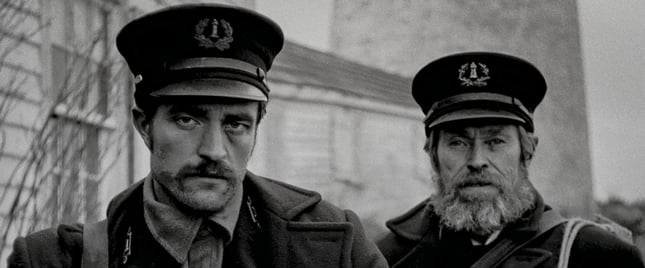In the Shadows of Madness: A Tale Illuminated by The Lighthouse
Cinemapedia
Robert Eggers’ The Lighthouse (2019) is a film that defies convention, plunging its audience into a visceral and psychological odyssey of isolation, madness, and obsession. Through its striking visuals, enigmatic story, haunting music, and thought-provoking moral themes, the film stands as a masterpiece of modern cinema—a tempest of chaos, myth, and human frailty.
A Stark and Hypnotic Nightmare
Visually, The Lighthouse is a feast of stark contrasts and atmospheric dread. Shot in black-and-white 35mm film with a nearly square aspect ratio (1.19:1), the film feels like a relic from another era, its imagery evoking the look of early cinema and maritime photography. Cinematographer Jarin Blaschke masterfully uses light and shadow to create a sense of foreboding and claustrophobia, immersing the audience in the desolate, storm-battered world of the lighthouse keepers.
The towering lighthouse itself becomes a character, its beam cutting through the darkness like an omniscient eye, both guiding and tormenting the men below. The framing of each shot feels deliberate and painterly, capturing the raw power of the sea, the suffocating confines of the lighthouse quarters, and the eerie isolation of the island. The film’s visuals are not just striking—they are an extension of its themes, reflecting the characters’ descent into madness.
A Descent into Obsession and Despair
At its core, The Lighthouse is a tale of two men—Thomas Wake (Willem Dafoe) and Ephraim Winslow (Robert Pattinson)—tasked with maintaining a remote lighthouse on a barren island. As the days stretch into weeks, their relationship becomes increasingly strained, their sanity fraying under the weight of isolation, the relentless roar of the sea, and the mysterious allure of the lighthouse’s beacon.
Eggers weaves a story that is both simple and deeply layered, blending elements of psychological horror, mythology, and existential dread. The plot teeters between reality and hallucination, leaving the audience to question what is real and what is the product of the characters’ unraveling minds. The film draws heavily from maritime folklore and Greek mythology, with the lighthouse’s light symbolizing unattainable knowledge or divine punishment, echoing the myth of Prometheus.
As their isolation deepens, the power dynamics between Wake and Winslow shift, their mutual distrust and suppressed emotions bubbling to the surface. The narrative is a slow-burn descent into madness, its ambiguity leaving room for interpretation and reflection.
A Symphony of Dread
The score by Mark Korven is an essential part of The Lighthouse’s atmosphere, enveloping the film in an almost unbearable sense of tension. The music is minimal yet deeply unsettling, combining droning bass tones, piercing horns, and eerie, otherworldly sounds that mimic the howling wind and crashing waves.
Equally haunting is the diegetic sound design—the relentless blare of the foghorn, the creak of the lighthouse stairs, and the ceaseless roar of the ocean. These auditory elements create an oppressive, inescapable soundscape that mirrors the characters’ mental torment. The film’s use of silence is just as powerful, allowing moments of quiet to feel charged with impending doom.
The Perils of Isolation and Obsession
The Lighthouse is a film rich with moral and philosophical underpinnings. At its heart, it is a meditation on the destructive power of isolation, unchecked ambition, and the human need for control. The characters’ descent into madness serves as a cautionary tale about the dangers of solitude and the psychological toll of power struggles in confined spaces.
The lighthouse’s light becomes a symbol of forbidden knowledge or divine judgment, drawing parallels to myths like Prometheus and Icarus. Winslow’s obsessive desire to gaze into the light reflects humanity’s insatiable thirst for understanding and control, even at the cost of self-destruction. Meanwhile, Wake’s authoritarian rule over Winslow highlights the corrupting influence of power and the fragility of human relationships under strain.
The film also explores themes of guilt, punishment, and existential despair, leaving the audience to ponder whether the characters are being punished by external forces or by their own inner demons. In the end, The Lighthouse suggests that madness is not born from isolation alone, but from the darkness we carry within ourselves.
A Masterpiece of Madness
The Lighthouse is a film that defies easy categorization, blending psychological horror, dark humor, and existential drama into a singular cinematic experience. Robert Eggers’ meticulous direction, combined with powerhouse performances by Willem Dafoe and Robert Pattinson, creates a film that is as mesmerizing as it is unsettling.
With its haunting visuals, atmospheric music, and deeply layered story, The Lighthouse is a work of art that challenges and provokes. It is a film that demands to be seen, discussed, and revisited—a tempestuous journey into the depths of the human psyche and the darkness of the soul. Like the light at its center, The Lighthouse beckons, even as it threatens to consume those who dare to look too closely.


